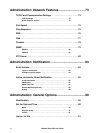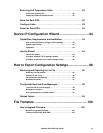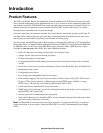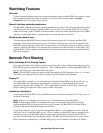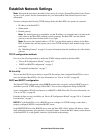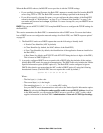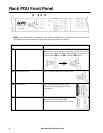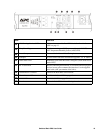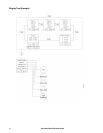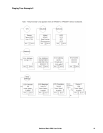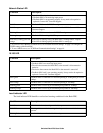6Switched Rack PDU User Guide
When the Rack PDU reboots, the BOOTP server provides it with the TCP/IP settings.
• If you specified a bootup file name, the Rack PDU attempts to transfer that file from the BOOTP
server using TFTP or FTP. The Rack PDU assumes all settings specified in the bootup file.
• If you did not specify a bootup file name, you can configure the other settings of the Rack PDU
remotely through its “Web Interface” on page 52 or “Command Line Interface” on page 7; the
user name and password are both apc, by default. To create a bootup file, see your BOOTP server
documentation.
DHCP. You can use an RFC2131/RFC2132-compliant DHCP server to configure the TCP/IP settings for
the Rack PDU.
This section summarizes the Rack PDU’s communication with a DHCP server. For more detail about
how a DHCP server can configure the network settings for a Rack PDU, see “DHCP response options”
on page 82.
1. The Rack PDU sends out a DHCP request that uses the following to identify itself:
– A Vendor Class Identifier (APC by default)
– A Client Identifier (by default, the MAC address of the Rack PDU)
– A User Class Identifier (by default, the identification of the application firmware installed on
the Rack PDU)
– A Host Name (by default, apcXXYYZZ with XXYYZZ being the last six digits of the PDU).
This is known as DHCP Option 12.
2. A properly configured DHCP server responds with a DHCP offer that includes all the settings
that the Rack PDU needs for network communication. The DHCP offer also includes the Vendor
Specific Information option (DHCP option 43). The Rack PDU can be configured to ignore
DHCP offers that do not encapsulate the APC cookie in DHCP option 43 using the following
hexadecimal format. (The Rack PDU does not require this cookie by default.)
Option 43 = 01 04 31 41 50 43
Where:
– The first byte (
01) is the code.
– The second byte (
04) is the length.
– The remaining bytes (
31 41 50 43) are the APC cookie.
See your DHCP server documentation to add code to the Vendor Specific Information option.
Note: By selecting the Require vendor specific cookie to accept DHCP Address check box
in the Web interface, you can require the DHCP server to provide an “APC” cookie, which
supplies information to the Rack PDU: Administration > Network>TCP/IP>ipv4 settings.



